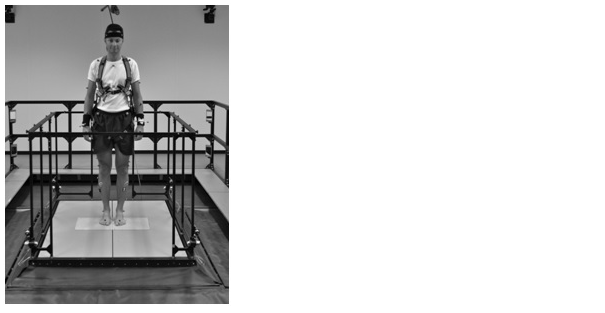Weight-bearing asymmetry is a common consequence of lateralized disorders, such as stroke. For stroke-survivors, bearing more weight on the unaffected leg often co-occurs with poorer postural stability. Weight-bearing asymmetry has therefore been regarded as a cause of this postural instability. However, weight-bearing asymmetry is only one of the many factors that can influence postural instability among patient populations. It is therefore difficult to appreciate the functional consequences of weight-bearing asymmetry in this group. We investigated the effect of weight-bearing asymmetry on balance recovery in healthy individuals to better understand its role in postural instability in patients.
We subjected ten healthy young individuals to translational stance perturbations in forward, backward and sideways direction at different levels of imposed weight-bearing asymmetry (0, 10 and 20% unloading of one leg). For each perturbation direction and each condition, we gradually increased the intensity (by increasing the perturbation platform’s acceleration) of the perturbations until participants had to take a step to recover their balance. This transition point from a feet-in-place to a stepping response was defined as the stepping threshold. Unloading of one leg resulted in higher stepping thresholds for perturbations towards that side. This can be explained by a larger initial separation between the center of mass and the base of support boundaries on the unloaded side, which creates more leeway for perturbations in this direction. As a consequence, stepping thresholds towards the loaded leg became smaller with greater weight-bearing asymmetry. We found no effect of weight-bearing asymmetry on forward and backward stepping thresholds and on the smallest distance between the extrapolated center of mass and the boundaries of the base of support. However, after a forward or backward perturbation, greater weight-bearing asymmetry resulted in a larger number of steps taken with the leg that was unloaded prior to the perturbation.

Experimental set-up
Our results illustrate that weight-bearing asymmetry in healthy individuals influences frontal plane stepping thresholds and results in more steps with the unloaded leg following sagittal plane perturbations. For people after stroke, these results imply that paretic leg unloading may to some extent serve as a compensation to increase lateral stability towards the paretic side, but at the cost of stability towards the non-paretic side. It may, however, also involve more paretic steps after backward and forward perturbations, which are likely of poorer quality than non-paretic steps.
Publication
de Kam D, Kamphuis JF, Weerdesteyn V, Geurts ACH. The effect of weight-bearing asymmetry on dynamic postural stability in healthy young individuals. Gait Posture. 2016;45:55-61.
About the Author

Digna de Kam
Radboud University Medical Center
Digna de Kam is a PhD candidate at the Radboud University Medical Center in Nijmegen, the Netherlands. Her work aims to better understand postural instability in older individuals and in people with neurological disorders. For that aim she investigates kinematic and muscle responses to postural perturbations with the Radboud Falls Simulator.
Copyright
© 2018 by the author. Except as otherwise noted, the ISPGR blog, including its text and figures, is licensed under a Creative Commons Attribution-ShareAlike 4.0 International License. To view a copy of this license, visit https://creativecommons.org/licenses/by-sa/4.0/legalcode.
ISPGR blog (ISSN 2561-4703)
Are you interested in writing a blog post for the ISPGR website? If so, please email the ISGPR Secretariat with the following information:
- First and Last Name
- Institution/Affiliation
- Paper you will be referencing
